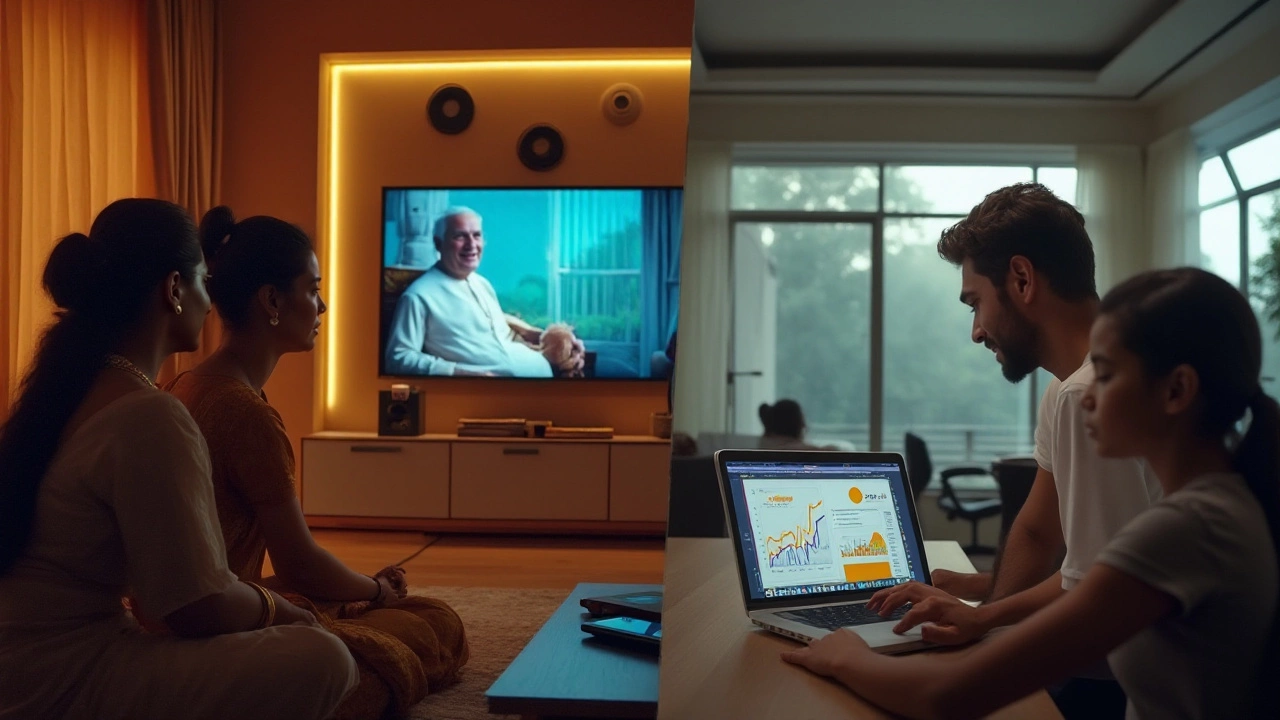Current Costs of 30-Second Commercials in 2025

Have you ever wondered how much it costs to broadcast a 30-second commercial in today's advertising world? The landscape of advertising is constantly evolving, and 2025 brings new challenges and opportunities for business owners eager to showcase their products.
The price of a 30-second spot isn't a one-size-fits-all deal. A lot goes into determining the cost—everything from the channel and time of airing to the targeted audience demographics greatly impacts what advertisers ultimately pay. This article delves into these components while shedding light on how you can make the most of your advertising budget.
- Factors Influencing Commercial Costs
- Television vs. Digital Platform Pricing
- Understanding Timing and Event Popularity
- Strategic Budget Allocation
- Tips for Maximizing Ad Spend
Factors Influencing Commercial Costs
When considering how much a 30-second commercial might cost in 2025, it's essential to understand the myriad factors at play. The primary aspect impacting cost is certainly the network on which the advertisement is broadcast. Leading networks with broad reach, like ABC or NBC, tend to command higher prices due to their large audience size. Meanwhile, niche channels might offer more affordable options if targeting a specific demographic. Time slots are another crucial element. Prime time, when viewers are most likely to tune in, can significantly hike prices. Late-night slots might be cheaper but also less effective, depending on the target market.
Moreover, the seasonality of an ad spot can impact the cost. High-profile events like the Super Bowl or the Academy Awards dramatically boost rates due to increased viewership. According to data, a Super Bowl commercial in 2024 cost around $6.5 million per 30-second slot. Holidays and national events see similar peaks, although they might not reach the same extreme prices as the Super Bowl. Such events are golden opportunities for brands looking to maximize exposure, albeit at a premium rate. Additionally, advertisers must consider whether they are running ads on traditional TV ads or newer mediums like streaming services.
In today's digitally dominated market, these newer advertising platforms provide alternative avenues that could be less costly than their traditional counterparts. However, it is worth noting that as digital platforms continue to grow in popularity, the cost of securing a place on these services is rising. A source once claimed, "Digital platforms are revolutionizing cost structures, offering flexibility that television never could." Digital ads often present the opportunity for more targeted and tailored campaigns, making them appealing to advertisers who prioritize ROI. Still, traditional television maintains influence, particularly in older demographics, essential for certain campaigns.
Production quality also carries significant weight in how much brands spend on their commercials. Hiring renowned directors and featuring celebrities can shoot up costs before the ad even airs. The pursuit of viral content drives many advertisers to spare no expense in creating a memorable ad. Longer-term campaigns might also mean multiple shooting locations and complex storylines. Nevertheless, not every successful ad needs to be a blockbuster production; at times, simple and clever ideas resonate just as well with audiences.
Additional Financial Considerations
There are also hidden costs involved when planning an advertising campaign, such as legal fees for copyrights and talent contracts. Negotiating media buys can be strategic, and some companies leverage partnerships or long-term contracts to secure better rates. With the evolving advertising landscape, keeping an eye on both direct and indirect costs assists in comprehensive budgeting. Businesses should perform robust market research and consult with advertising professionals to optimize their advertising budgets effectively.
Television vs. Digital Platform Pricing
As the advertising landscape continues to evolve, businesses are faced with the decision of choosing between traditional television and digital platforms for their ad campaigns. Both avenues present unique opportunities and challenges, each with its own pricing structure influenced by various factors. Understanding these differences is crucial for determining how to effectively allocate an advertising budget in 2025.
When it comes to traditional television, the cost of a 30-second commercial heavily depends on the network, the time slot, and the show's anticipated viewership. Prime-time slots on major networks can still command astronomical prices, especially during high-profile events like the Super Bowl or the Oscars, where the audience is vast and diverse. In recent years, reports have noted that a 30-second spot during the Super Bowl can exceed $7 million, highlighting the continued value and influence of television advertising. These commercial spots often appeal to companies aiming to generate widespread awareness and brand recognition.
Digital platforms, on the other hand, offer a level of flexibility and customization that traditional television cannot match. Social media sites, streaming services, and video-sharing platforms like YouTube allow businesses to target specific demographics with far greater precision, making it a cost-effective option for many. The pricing on these platforms is not static and can vary based on the ad format, placement, and bidding strategies in place. For instance, while creating a video ad for YouTube might have a lower entry cost, advertisers should consider bidding strategies and viewer engagement metrics, which can escalate expenses depending on the competition.
Cathy Colliver, a digital advertising specialist, once noted, "The key with digital ads is not necessarily spending a ton but spending smart. You get to choose when and where your ad runs, and more importantly, who sees it."
Despite television's dominant placement costs, it's important to recognize that digital advertising allows brands to maximize their reach with detailed tracking capabilities and analytics. These platforms also enable businesses to adjust their messaging in real-time based on feedback and performance data, an advantage traditional television does not offer. It positions businesses to make quick decisions, ensuring improved effectiveness. However, brands must navigate issues like ad-blockers and shorter attention spans. This dynamic offers opportunities and necessitates creative storytelling to ensure viewer engagement.
Increasingly, many businesses are pursuing a hybrid approach where they utilize both traditional TV and digital platforms to maximize their advertising reach. This allows them to leverage the mass appeal of television while taking advantage of the specific targeting capabilities of digital. Balancing these two can be challenging but, when done correctly, can offer a wide-reaching and highly effective advertising strategy. Businesses must stay informed of the latest trends and continuously reassess where their target audiences spend their time. By doing so, they can better plan engaging and cost-efficient advertising campaigns that deliver results.

Understanding Timing and Event Popularity
Among the myriad factors influencing the cost of a 30-second commercial, timing and event popularity are significant drivers that demand careful consideration. Advertising at specific times can either be a strategic boon or a budgetary bane. Prime time slots, typically between 8 PM and 11 PM, often see higher ad rates due to increased viewership. This is a golden period when people settle in after dinner, offering a ripe opportunity to capture attention, but it comes with a price.
Television today is not just about regular programming; there are landmark events that create opportunities for heightened brand exposure. Events such as the Super Bowl have become legendary, not only for the sports but for the commercials that air. According to a report from 2024, a 30-second spot during this single event cost businesses an astounding $7 million, reflecting the scale and impact such moments can have. Advertisers jostle for these slots, recognizing the event's potential to be a cultural touchstone that amplifies their message.
However, it isn't just about aiming for these exuberantly priced slots. A savvy advertiser assesses when their specific audience is most likely tuning in based on data analytics and consumer behavior studies. For instance, advertising children's toys during weekend morning cartoons could provide more value than targeting the same during a primetime show. It's about aligning with the audience's lifestyle and viewing habits to ensure optimal reach and impact. Interestingly, the digital revolution has also allowed for more precise targeting, enabling brands to hit the sweet spot every time.
Data tracking tools today help businesses better understand when their advertisements will likely generate the most returns. For those eyeing television, Nielsen's ratings provide detailed insights into viewer numbers and demographics per program, bridging the gap between potential and actual viewership. Meanwhile, the digital side offers its arsenal of analytics, from Google's AdWords metrics to Facebook's Ad Insights, to pinpoint exact timing for releasing ads. Using these resources wisely can vastly improve a campaign's effectiveness.
"Timing is everything," says Lauren Isley, CEO of a prominent advertising agency. "You can have the best message, the clearest call-to-action, but if you miss your audience’s optimal viewing window, it’ll feel like talking into a void."
To truly maximize the return on your advertising budget, businesses must not only focus on when their products are likely to sell best but also when their audience is most receptive to their message. It's a dance of precision, combining the allure of pop culture events with the shrewdness of data-driven decisions. Understanding these dynamics allows brands to navigate the complex landscape of advertising costs, strategically investing their resources where and when it counts the most. Thus, timing not only influences costs but also enhances the value received in an unpredictable market.
Strategic Budget Allocation
Determining where and how to allocate your advertising budget is a nuanced task that demands a keen understanding of your brand's broader goals and the evolving media landscape. For many, the allure of investing in a 30-second commercial during peak television hours is undeniable—it's a classic method of quickly reaching a mass audience. However, this approach can devour budgets swiftly if not approached strategically. The key is to balance your spend across multiple platforms, ensuring both coverage and effectiveness. Consider the potential of diversifying into digital platforms, where, often, the reach can be amplified with a fraction of the cost traditional media commands.
To start, identify the core demographic you're aiming to reach. Research their viewing habits—are they adhering to traditional TV, or have they migrated to streaming platforms? This understanding is crucial. Align your spend with the platforms they frequent most, whether that's cable networks, popular streaming services, or even social media. An insightful quote from renowned marketing strategist, Seth Godin, summarizes this nicely:
"Don't find customers for your products, find products for your customers."Applying this principle positions your budget effectively, ensuring your brand is where your audience naturally gathers.
Another strategic element involves time-sensitive opportunities, like major events or holidays, when viewers are most engaged. Allocating a portion of your budget for such events can drastically boost ad performance. But remember, these slots are competitive and require timely bookings and often higher fees, especially for sought-after spots like the Super Bowl or prime-time finales.
If your product or service benefits from regional targeting, consider geographically-tailored buys. Local networks often offer more affordable rates and provide the flexibility to test different messages or creative styles. This tactic not only saves on costs but also enables brands to hone in on what resonates with specific audiences.
A balanced and adaptive advertising strategy should also involve continual analysis and refinement. Regularly consulting performance data allows marketers to shuffle their investments, maximizing return. Using performance metrics, like conversion rates or viewer engagement levels, provides clarity on what's working and what's not, thus informing future budgetary decisions.
Here’s a practical approach: implement a phased budget strategy. Start with an initial testing phase using a smaller portion of your budget to gauge effectiveness. Armed with insights, gradually increase investments in areas showing high returns. This data-driven approach reduces risk and enhances the efficiency of your overall spend.
The era of blindly pumping money into advertising is long past. Today's savvy marketers blend intuition with empirical data to refine strategies continuously. By doing so, they optimize their expenditures, balancing their budgets across all available channels to not just reach, but effectively engage, their audience.

Tips for Maximizing Ad Spend
Maximizing your ad spend in today’s competitive advertising environment involves more than just throwing cash at the biggest networks or most popular digital platforms. It requires a strategic approach, focusing on getting the best possible return on investment for every dollar spent. First and foremost, understanding your target audience is crucial. Delve into demographic data, preferences, and behaviors to tailor your message effectively. Without this insight, even the most creative ad may miss the mark and fail to engage. Consider conducting market research or using analytics tools to gather detailed insights about your consumer base.
Collaboration with media buying agencies can also add significant value. These agencies have a profound understanding of the intricate media landscape and can often negotiate better rates. By working closely with them, businesses can secure prime spots during high-traffic events, optimizing their reach. Ensure you communicate your goals and budget clearly to maximize their expertise effectively. Moreover, consider mixing traditional TV ads with digital platforms. This blended strategy not only broadens your reach but also allows you to measure engagement through digital analytics tools. This dual approach helps in adapting the campaign strategy in real-time based on the audience's reaction.
Timing plays a pivotal role, too. Advertisers benefit significantly from airing commercials during peak viewing times or major events. While these slots can be expensive, they often provide the most substantial visibility which could potentially lead to higher conversion rates. Keep an eye on upcoming events that are relevant to your industry. For instance, products targeting a sports audience might see more engagement when advertised during a major football game.
To maximize ad spend, it's equally important to consider content quality. Investing in high-quality production can set your commercial apart from the clutter, resonating more profoundly with viewers. Storytelling is a powerful tool—creating relatable, emotional narratives can engender a strong connection with your audience. As advertising legend David Ogilvy once said,
"The best ideas come as jokes. Make your thinking as funny as possible."Humor or emotionally appealing content often has a higher retention rate, making your brand more memorable.
Lastly, measure the performance of your commercials through key performance indicators (KPIs) like reach, frequency, and conversions. Keep track of these metrics consistently to understand what works and what areas need a tweak. A/B testing different versions of your ads might reveal what resonates best with your intended audience. By analyzing these data points, you can fine-tune your strategy to bolster effectiveness, ensuring that every cent invested in your commercial cost delivers value. Tailor your messages based on these insights and continue to refine them to maintain a competitive edge in the dynamic advertising world of 2025.









Write a comment